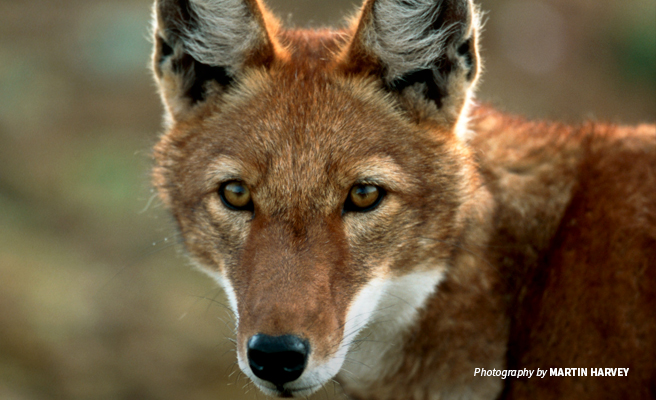Saving the critically endangered Ethiopian wolf from extinction

To make the greatest conservation impact, AWF uses a range of strategies to protect species in priority landscapes. Though our work is organized around iconic wildlife such as elephants, rhinos, and large carnivores, we design our programs to benefit local human communities as well as all indigenous wildlife and habitats. Among the key species we focus on is one of the world’s rarest canids, the Ethiopian wolf.
Also known as the Simien fox or Simien jackal, this highland wolf numbers no more than 440, and perhaps as few as 360, making it Africa’s most endangered carnivore. Although scientists debate which canids are wolf species versus subspecies, the traditional view is that there are three wolf species in the world — the Ethiopian, red, and grey wolf. The Ethiopian wolf is the only wolf species native to Africa and is found in only seven Ethiopian mountain ranges, with the largest populations in the Bale Mountains and the second largest in the Simien Mountains.
Endemic and endangered
With a somewhat regal bearing, the Ethiopian wolf is the size of a coyote and looks like a red fox, sporting a tawny orange or reddish coat, white throat patch, and bushy tail. It has a narrow muzzle, long legs, and pointed ears.
Although shy around humans, it is social with other wolves, living in packs that typically include extended family members male and female. All pack members help with raising and protecting pups.
Wolf mothers give birth in dens dug under boulders, inside crevices or in other protected spots. These dens can have multiple entrances and a network of tunnels, and the adults regularly shift pups from one den to another.
For food, the Ethiopian wolf depends on high-altitude rodents, especially the big-headed mole-rat, which tunnels to foraging spots but feeds above ground. The Ethiopian wolf is a loner when hunting, but even here it may rely on others for help. Scientists have noted that Ethiopian wolves forage right in the middle of gelada herds, large groups of primates of also known as “bleeding heart monkeys”. The wolves do not prey upon the geladas’ young, and the geladas do not flee from the wolves like they do from feral dogs. Researchers have found the wolves capture rodents at twice the rate when hunting in a gelada group. It is not clear why they have greater success; perhaps the geladas flush rodents out of their burrows by disturbing vegetation. Or, it could be the wolves blend in with the scattered geladas, and the rodents simply do not notice them.
Community-led initiatives safeguard the Ethiopian wolf
With numbers so small, Ethiopian wolves are highly vulnerable to disease outbreaks, and in the past few years, they have experienced devastating rabies and distemper outbreaks. AWF supports the Ethiopian Wolf Conservation Programme, which administers rabies and distemper vaccines to the wolves, but also to area domestic dogs, who can carry rabies and pose a significant disease threat if not vaccinated. To date, the program has vaccinated tens of thousands of dogs.
In partnership with the Ethiopian government, the Ethiopian Wolf Conservation Programme also recruits local community members to act as Wolf Monitors and Wolf Ambassadors who track wolf populations and share conservation messages in communities. The monitors are very dedicated and work through all kinds of conditions to follow the wolf packs and keep up with their status and life events. This work is critical to ensuring a rapid response in the case of disease outbreaks.
AWF’s work in Ethiopia incorporates our Classroom Africa program. In exchange for a conservation commitment from the Adisge community near Simien Mountains National Park, Classroom Africa rebuilt the community’s badly under-resourced school.
The new Adisge Primary School opened its doors in 2017. For the first time, the school has enough space to enroll 7th and 8th graders. The re-design has made the Adisge school eco-friendly and comfortable, and the site includes new teacher housing as well.
Classroom Africa fosters a conservation ethic among young people through eco-clubs and field trips to national parks and other protected areas. The goal is to develop a new generation of local conservation leaders who will be passionate about protecting wildlife.
AWF also has invested in high-end eco-lodges in the Simiens and Bale Mountains parks that help create jobs from nature-based tourism. In addition, we support the Ethiopian Wildlife Conservation Authority, which manages both parks, to improve park infrastructure, management and strategically promote tourism.
Update: We spotted Ethiopian wolf pups. Here's why that's good news.